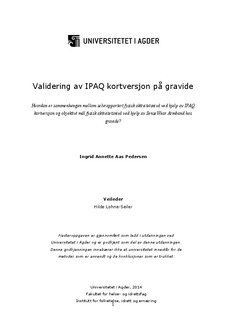| dc.description.abstract | Background: Physical activity promotes good health and involves a number of positive
benefits through pregnancy. With this in mind it is therefore important to have good
measuring methods of physical activity in order to facilitate a health promoting lifestyle in
pregnant women.
Objective: The main aim of this study was to validate IPAQ short version in order to examine
whether this questionnaire is a valid method to use when the goal is register pregnant
women’s physical activity level. This study is a validation study and is a part of the study “Fit
For Delivery” (FFD), a randomized controlled intervention study, which investigates the
effects of lifestyle changes during pregnancy.
Method: Physical activity was recorded using the IPAQ short version, subjective
measurement method, against an objective measurement method (SWA). The participants
wore SWA for seven days and responded to the IPAQ questionnaire afterwards. The people
involved in the study were recruited from two clinics in Kristiansand and from the Women’s
Clinic at “Sorlandet” Hospital. In total, 20 pregnant women were included in the study.
Results: There was a weak correlation(r=0.028, p=0.36) for Sedentary, and in terms of
Moderate intensity and Moderate+go intensity there was a negative weak correlation (r=-0.30,
p=0.86; r=-0.30, p=0.86), and for High intensity it was a significant moderate correlation
(r=0.42, p=0.03) between self-reported physical activity and objective measured physical
activity. There was an under-reporting of 7.2 hours (71.5%) for Sedentary, and 41.7 minutes
(70%) of Moderate intensity, and an over-reporting of 126.2 minutes (14.2 %) of
Moderate+go intensity.
Conclusion: These findings indicate that IPAQ short version seem to be a less valid method in
terms of registering physical activity for Sedentary, Moderate intensity and Moderate+go
intensity. Otherwise, IPAQ seem to be a more valid method regarding High intensity. Further
investigation should be done to validate self-reported physical activity in a group of pregnant
women accounting for a number of more than 20 participants.
Keywords: Pregnant women, IPAQ, subjective measurement, validation study | nb_NO |
